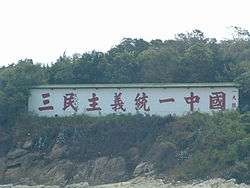Cross-Strait war of propaganda

A propaganda sign on Kinmen facing Mainland China proclaiming "Three Principles of the People unite China"

A propaganda sign on Xiamen facing Kinmen proclaiming "One country, two systems, peacefully unite China"
The cross-Strait war of propaganda (simplified Chinese: 台海心战; traditional Chinese: 台海心戰) refers to a period of time following the Second Taiwan Strait Crisis when the two Chinese governments, the Republic of China (ROC) on Taiwan and the People’s Republic of China (PRC) on the mainland, engaged in mutual propaganda actions aimed at turning military personnel against their own regimes and encouraging them to defect. Such activities didn’t stop until 1990. Both sides used megaphones and radio stations for broadcasting, and balloons and floating carriers for sending leaflets and other objects. Defectors came from both sides, bringing with them information and intelligence about their original regimes.
See also
This article is issued from Wikipedia - version of the 6/17/2016. The text is available under the Creative Commons Attribution/Share Alike but additional terms may apply for the media files.